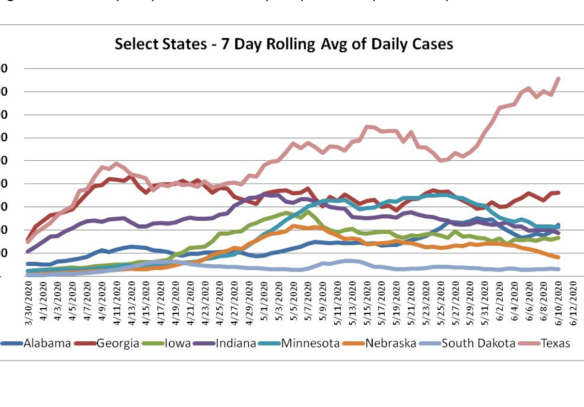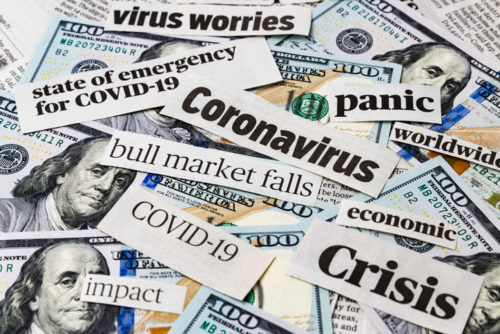by David Lieberman
Managing Partner, Portfolio Manager
We have often covered the realities of the media’s natural bias to oversell a catastrophe in the interest of generating more traffic. Initially, the media missed the opportunity to report how likely Covid-19 was to become a worldwide pandemic and catastrophe. But the media is now working on overdrive to make up for lost time. Many sources are reporting that Houston, Texas and Arizona, among other states, are experiencing surges in case counts and hospitals near capacity. But these depictions aren’t entirely accurate and suggest a more dire situation than is appropriate.
In the early days of C19, hospitals in the NY metropolitan area were completely overwhelmed. Hospital bed capacity in the tri-state accounted for by C19 patients was at least 60% and often well over that level for weeks. Many hospitals stopped taking new patients because they had no additional capacity and the city prepared to be overwhelmed by converting the Javits Convention Center into a massive hospital facility, placing medical tents in Central Park, and receiving a military hospital ship from the Federal government. The large regional hospital where my wife works built an additional 74 full rooms by converting the entire cafeteria into additional bed and bathroom capacity and that construction was completed in a week. That was both unfathomable and impressive in the face of tremendous bed shortages. Fortunately, much of this capacity was never needed.
But this message of immediate catastrophe is now being told about other regions. Houston is one such location where some are describing it as being, “on the precipice of disaster.” This is an incredibly effective headline title at generating fear and a response, but Houston’s situation is not nearly as dire as the headline depicts. In fact, as of June 10th only 15% of Houston area ICU bed capacity was being used by C19 patients, while 61% of the beds was being used by non-C19 patients. So while the entire system is using 76% of bed capacity, most of the capacity is used by non-C19 patients.

Houston is also nowhere near running out of personal protective equipment, such as N95 masks, gloves, and gowns. Right now they have a 4-month supply of N95 masks, over a 30-day supply for gloves, and nearly a 6-month supply for gowns. In the NY metro area, N95 masks were literally out of stock at several hospitals, and physicians everywhere were asked to re-use them over and over. My wife was allocated one mask to re-use until it was unusable or until supplies improved. This is not the situation in Houston.
Finally, it is true that case counts are climbing in Houston, but they are not climbing very rapidly. Cases are growing around 2-5% daily. Houston is now reporting around 400 new cases daily, up from about 300 cases in late May. The trend has increased slowly. Hospitalizations are also increasing, but at a slower rate than case growth, because testing is also rising more sharply, so it is capturing more infected patients. Houston case counts have increased by less than 20 patients daily in the past 2 weeks. This should clearly be monitored, and adjustments will need to be made in order to reverse this increasing trend. By contrast, New York City was experiencing increased hospitalizations of approximately 1,000 cases per day in late March and early April. So the rise in cases in Houston, while undesirable, is actually modest in comparison.
Arizona is another state where case counts are climbing and, on a per-capita basis, are probably climbing more rapidly than any other state in the country. But deaths have not yet increased and have slowly been trending lower. As reported by the Wall Street Journal, about 25% of the cases are being found on Indian reservations, one of the nation’s most at risk populations. Arizona is also seeing high case counts for green card holders fleeing Mexico, where hospitals are being overwhelmed. Even so, Arizona has plenty of hospital capacity available. Also, when the areas of infection are concentrated, such as on Indian reservations, it provides a targeted opportunity to specifically address the causes of those outbreaks.

Also note that forecasts by the University of Washington show that the number of confirmed infections has increased but its estimate of actual infections is now falling. If you use this link, https://covid19.healthdata.org/united-states-of-america/arizona you can see these forecasts for each state in the country. About half way down the page is a graph labeled “daily infections and testing.” Testing continues to increase, which is capturing a larger share of the actual cases. The khaki band around the dotted line is their 95% confidence interval, and that wide band shows that it is possible that cases may still be climbing. While the range is quite wide, the base case is that actual (as opposed to confirmed) infections are already declining. Even if actual cases are flat or growing slightly, the trend indicates that the state government would have plenty of time to respond to improve policies to reverse the trend.
Further down on that same page, you will also find an estimate of hospital resources. And this forecast shows that Arizona will peak at about 20% of hospital beds used by Covid patients. Among ICU beds, it is estimated that they will reach 60% of capacity (or 10% higher than current levels), and the 95% confidence interval shows potential expansion of that capacity. But in comparison, NJ was using five times its measured ICU capacity by late April. Independent reporting from Arizona indicates that its hospital resource capacity is being absorbed at a relatively slow rate of increase in the low to mid-single digit percentages daily.
Key Conclusions
State governments across the U.S. are electing to open businesses and activities to varying degrees. This provides a natural experiment to see what works and what doesn’t. It makes sense to test the waters to see how open we can drive our economies in order to find a model that maximizes economic improvement, while minimizing Covid-19 exposure risk. We are still learning. Despite the early and erroneous advice from the CDC about wearing masks, we now know that it is highly effective. It was recently reported that two hair stylists who saw 140 clients while symptomatic ended up not infecting a single person. Both the hair stylists and clients wore masks. This kind of experience is critical to learn how to best open an economy and only by testing the waters can we learn how far we can safely go.
Arizona and Houston have certainly pushed the limits and have been liberal about their policies and individual behaviors. Masking is not widely used in either location and social distancing has been much lower than in the states which were initially hit hard. They will need to adopt better Covid-19 protection measures in order to continue to drive case counts down. Over time, we will refine the practices needed to better protect ourselves from this virus. But in the meantime, we should continue to focus on the big picture. Cases are not exploding in either Arizona or Houston. Neither location is likely to be overrun by Covid-19, and actual cases may already be declining. It is important not to overreact, but to respond with data and calculated thought. The media is not incentivized to do so.
The sensitivity of investors remains very high, as easily demonstrated by the market’s violent response to incoming pandemic data and interpretations of that information, so volatility should be expected to remain. A large decline in Q2 GDP is certain, although incoming data suggests that fears of a 40% decline in Q2 may have been too pessimistic. It is very difficult to get a good read on the pace of recovery when the estimate of the decline is so uncertain. What we do know is that the economy is being reopened and a recovery has begun. And it is clear that the Fed and the Treasury remain committed to promoting a rebound.
Footnotes
1 https://news.bloomberglaw.com/coronavirus/houston-may-reopen-virus-hospital-at-stadium-as-cases-expand
2 https://www.tmc.edu/coronavirus-updates/proposed-early-warning-monitoring-and-mitigation-metrics/
3 https://www.tmc.edu/coronavirus-updates/proposed-early-warning-monitoring-and-mitigation-metrics/
4 https://www.tmc.edu/coronavirus-updates/daily-cumulative-covid-19-positive-cases-for-greater-houston-area/
5 https://forward.ny.gov/daily-hospitalization-summary-regionhttps://www.azdhs.gov/preparedness/epidemiology-
6 disease-control/infectious-disease-epidemiology/covid-19/dashboards/index.php
ACM is a registered investment advisory firm with the United States Securities and Exchange Commission (SEC). Registration does not imply a certain level of skill or training. All written content on this site is for information purposes only. Opinions expressed herein are solely those of ACM, unless otherwise specifically cited. Material presented is believed to be from reliable sources and no representations are made by our firm as to another parties’ informational accuracy or completeness. All information or ideas provided should be discussed in detail with an advisor, accountant or legal counsel prior to implementation. All investing involves risk, including the potential for loss of principal. There is no guarantee that any investment plan or strategy will be successful. ©ACM Wealth

